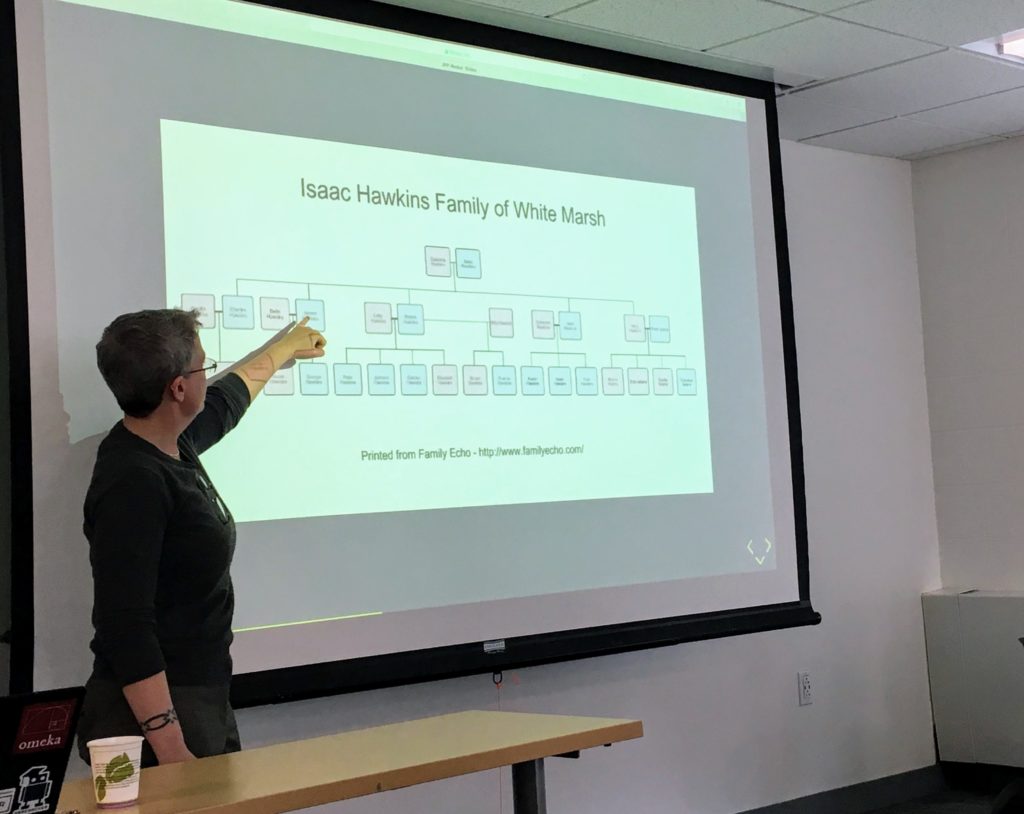By Lara Rose
In this early spring talk, Sharon Leon outlined how her archival research has brought to light information about 1,000 enslaved persons who resided on or nearby the Jesuit Plantations of Maryland in the century before the 1838 sale that transferred nearly 280 persons from the hands of the Jesuits into those of slaveholders in Louisiana. Though the knowledge of this sale has existed for decades, the question of what Georgetown University owes to the descendants of the enslaved persons who were sold has gained recent attention and a resurgence of interest has been forming in the scholarly community to track information about these people and their descendants. Sharon Leon is working to discover what she can about the lived experiences of the enslaved people on the Jesuit lands, sharing her research through the Jesuit Plantation Project web interface.
Leon outlined for the audience the meticulous detail she has been tracking through archival records: hand-keying with unique identifiers information on death dates, birth dates (inferred from ages recorded on various records), sacramental marriages, baptismal records, and bills of sale. Her records stretch over the present state of Maryland, on nine Jesuit plantations: Fingale, Port Tobacco, Georgetown College, White Marsh, St. Thomas’s Manor, St. Joseph’s Manor, St. Inigoe’s Manor, Newtown, and Bohemia. A driving question for her research: does the lived experience of enslaved persons on a Jesuit plantation differ significantly from the experience of slavery elsewhere?

When searching for answers in the archival records, Leon discovered the yearly allotments of clothing given to each man, woman, or child (blankets were only given “when necessary”); she found a document that dictated the plot of land given to each individual to tend (100 x 40 yards for a single male, 200 x 40 yards for a couple), and she discovered receipts from enslaved persons selling and buying crops to and from the plantation itself. Several times over the course of the talk, Leon emphasized the impossibility of guaranteeing the veracity of the records, particularly in one account that claimed that enslaved persons earned $100/year from sales of their crops, livestock, or oysters (gathered “against the direction of authority” and sold to sailors).
While the uncertainty in the records makes comparison difficult, Leon was able to identify one area in which the lives of enslaved persons on Jesuit plantations do seem to have been distinct from those of enslaved persons elsewhere: in the greater permanence of their marriages, made evident in the marriage and baptismal records Leon has been studying. She has found that the Jesuits did support marriages between members of the enslaved community, and even went to great lengths to keep marriages together when one member of the partnership would be sold. Although we cannot know now whether those marriages were coerced or represented moments of agency for each individual, we do know they occurred. Even when the records do not show an official marriage in the church, we can see the birth of a child as a record of a connection between persons.
Leon initially hoped that these connections between individuals could be traced and analyzed with Social Network Analysis (SNA), but, at this point in the talk, she paused for a call for help. The social networks have not revealed information much deeper than that which can be gleaned from a family tree visualization—in part because of the vast incompleteness of the data. So she put the question to the audience: Does SNA make sense for such an incomplete dataset? Beyond that, what is the best way to graphically represent tenuous concepts like “marriage events,” when we cannot know whether those events were voluntary or coerced? Furthermore, how can the information be visualized and analyzed in a way that would be most meaningful to the people for whom this information matters most: the descendants of these enslaved individuals?
We were lucky enough to hear this presentation at a key moment in the juncture of a project which reveals how work in digital humanities, public history, and the archives can be deeply challenging: much of the archival work is finished, but how can it best be used? As the title of Sharon Leon’s presentation hints, any attempt at visualizing such incomplete and fraught data as the information about enslaved persons will always be a reduction of their lived reality. Can we embrace the redux while still fulfilling the promises we made to the scholarly community, institutional supporters, and the public?



